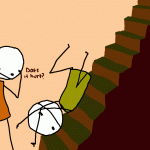 Falls and stumbles are TEN times more likely in patients with myotonic Dystrophy that in a normal healthy population. One reason for the fall or stumble would be for a sustained muscle contraction that can not be counterbalanced by other muscles. Fall prevention programs should be implemented for patients with DM.
Falls and stumbles are TEN times more likely in patients with myotonic Dystrophy that in a normal healthy population. One reason for the fall or stumble would be for a sustained muscle contraction that can not be counterbalanced by other muscles. Fall prevention programs should be implemented for patients with DM.
J Neurol Neurosurg Psychiatry. 2006 March; 77(3): 393–396.
Falls and stumbles in myotonic dystrophy
Abstract
Objective
To investigate falls and risk factors in patients with myotonic dystrophy type 1 (DM1) compared with healthy volunteers.
Methods
13 sequential patients with DM1 from different kindreds were compared with 12 healthy volunteers. All subjects were evaluated using the Rivermead Mobility Index, Performance Oriented Mobility Assessment, and modified Activities Specific Balance Confidence scale. Measures of lower limb muscle strength, gait speed, and 7‐day ambulatory activity monitoring were recorded. Subjects returned a weekly card detailing stumbles and falls.
Results
11 of 13 patients (mean age 46.5 years, seven female) had 127 stumbles and 34 falls over the 13 weeks, compared with 10 of 12 healthy subjects (34.4 years, seven female) who had 26 stumbles and three falls. Patients were less active than healthy subjects but had more falls and stumbles per 5000 right steps taken (mean (SD) events, 0.21 (0.29) v 0.02 (0.02), p =
= 0.007). Patients who fell (n
0.007). Patients who fell (n =
= 6) had on average a lower Rivermead Mobility score, slower self selected gait speed, and higher depression scores than those who did not.
6) had on average a lower Rivermead Mobility score, slower self selected gait speed, and higher depression scores than those who did not.
Conclusions
DM1 patients stumble or fall about 10 times more often than healthy volunteers. Routine inquiry about falls and stumbles is justified. A study of multidisciplinary intervention to reduce the risk of falls seems warranted.
